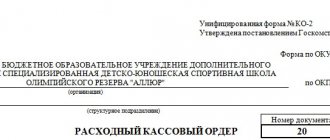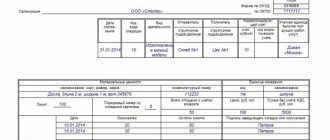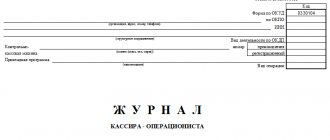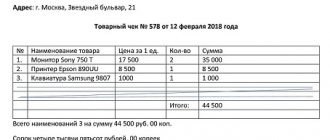Where can I get a free cash receipt order?
You can receive a cash receipt order (CPO) on our website:
We offer you free software in the 2 most common file formats - Word and Excel. In this case, the already completed form is presented in Excel, located below.
However, downloading a cash receipt order is not all; you should make sure that this is the current form of the document.
NOTE! As of August 19, 2017, new rules for conducting cash transactions are in effect, which you can read here.
The link through which you can use the PQR on our website will contain a document that meets all legal requirements. Let's look at them.
Filling out cash receipt orders online and using programs
The law allows you to draw up PKO not only manually, but also in typewritten form using automated tools and various online accounting services.
The most common programs are the products of the company 1C, INFO-Accountant, BEST, Parus, ABACUS, Galaktika. With their help, the process of registering cash registers is accelerated, as well as the numbering of cash orders and the maintenance of a journal for registering cash documents are automated. Online accounting services such as “Moe Delo”, “SKB-Kontur”, “Bukhonline” have also become widespread among accountants. A positive aspect of using these software products is the regularly updated database of regulatory documents.
Useful articles:
Useful articles:
What requirements must the cash receipt order form meet?
On our website you can use the KO-1 form (corresponding to OKUD number 0310001), approved by Decree of the State Statistics Committee of the Russian Federation dated 08/18/1998 No. 88. Russian organizations are prescribed to use only this form by Bank of Russia Directive No. 3210-U dated 03/11/2011.
For more information about what standards primary documents must comply with, read the article “Primary document: requirements for the form and the consequences of violating it .
NOTE! Individual entrepreneurs who, in accordance with the legislation of the Russian Federation on taxes and fees, keep records of income or income and expenses and (or) other objects of taxation or physical indicators characterizing a certain type of business activity, may not draw up cash documents and a cash book (clauses 4.1, 4.6 of instruction No. 3210-U).
Filling out the book
There are some features of filling out KO-4 forms. So, on the title page, details regarding the enterprise are entered, including the company name, OKPO code, and structural unit, if any. After this, the period for maintaining the book is recorded - this can be a month or a year.
Information that needs to be entered on sheets inside the book:
- Date the page was completed.
- In the “balance” line, write down the amount of funds that are in the cash register at the beginning of the day. In this case, you need to take the “remaining” record from the previous day.
- Next, enter data on issued orders.
- In the “transfer” line, enter the data on the income and expense amounts from the previous lines.
- Next is the total amount for orders and the balance in the cash register.
- At the very end of the completed sheet, data is entered in words regarding the number of orders issued on the current day.
If any lines are left blank, they are crossed out. When entering data, corrections are prohibited, as this may indicate fraud. When an error is made, you should obtain a confirmation signature from the cashier who fills out the book.
Below you can download a sample of entering data into the KO-4 forms.
How to fill out the PKO form
cash receipt order is the first stage of the task, and the next step will be to correctly fill out this document. A completed PQS sample may look like this:
A cash receipt order can be issued on paper or using technical means - data is entered on a computer, then the PKO is printed and signed. In addition, the receipt can be issued in electronic form, provided that it is protected from unauthorized access, distortion and loss of information. In this case, the PKO is signed with an electronic signature (clause 4.7 of instruction No. 3210-U).
You can print out the completed sample cash receipt order and place it on the cashier’s desk along with instructions for filling it out, which we will provide below.
Features of management
According to the law, maintaining a cash book, the form of which in Word can be downloaded from us, is allowed in two formats:
- On paper. To do this, print out the form provided and fill out the required fields by hand. In this case, the signature of the person in charge (cashier) must be required.
- In electronic format – forms are saved on a computer and can also be filled out digitally. In this case, protection against illegal access is required - an electronic signature is used for this.
Regardless of how many areas of activity a company has, only one cash book is maintained. This also applies to working on different tax schemes. If there are separate divisions, they maintain the KO-4 format form at their place, and copies of the sheets are sent to the parent company. The procedure for such reporting forms the statute of the organization and the procedures for drawing up financial statements.
The cashier enters the data into the form, and at the end of each working day there must be a reconciliation of the details entered in the book and those contained in the PKO and RKO. After this, the cash balances are calculated, if the results match, then a signature is affixed to close the day.
Important! After the cashier, the same data will be verified by an accountant or directly by the manager; his signature is also required in the appropriate column.
If there are no monetary transactions during the day, the information is not recorded in the book.
Filling out the PKO form: nuances
There are a number of nuances that characterize the procedure for filling out a cash receipt order form. Let's look at them.
The “Structural unit” column should be filled out only if cash is accepted from an employee of the organization. If they are transferred by another legal entity or individual, then a dash should be placed in the corresponding paragraph of the form.
The “Debit” and “Credit” items contain the accounts of the Chart of Accounts (approved by Order of the Ministry of Finance dated October 31, 2000 No. 94n) in accordance with the essence of the business operation.
The column “Purpose code” is filled in by organizations that use the appropriate coding system.
The column “Amount of rubles, kopecks” of the KO-1 form is filled in only with numbers, rubles and kopecks are separated by a comma (for example, “200.75”). In the “Amount in words” column, rubles are indicated in words (the first word is capitalized), and kopecks are indicated in numbers. You should also put a dash (if the document is filled out on a computer, then a continuous sequence of consecutive dashes) in the empty spaces of the corresponding column after indicating the amount in words.
If the company does not work with VAT, then in the “Including” column you should enter “Without VAT”. Otherwise, the corresponding VAT amount.
In the “Appendix” paragraph, you should record the primary documents that are the basis for entering figures into the PKO (for example, a cashier’s report).
In addition to the main part of the KO-1 form, you will also need to fill out a receipt, which is included in the structure of the PKO. The receipt will appear in the document on the same page as the main part of the form. As for affixing the seal, based on business customs, the seal is often affixed so that part of it is on the receipt, and the other part is on the PKO. Please note that in this case, claims from the tax authorities are possible. However, you can try to challenge them (see, for example, the decision of the Seventh Arbitration Court of Appeal dated 04/06/2010 No. 07AP-1517/10). In addition, today such disputes seem to us to be of little relevance, since in connection with the entry into force of the law of April 6, 2015 No. 82-FZ, the seal for organizations has ceased to be a mandatory requisite.
See also the material "Print is not a mandatory attribute of the primary document . "
The order must be signed by the cashier or other authorized person. The cashier checks the signatures of authorized persons on the PCO with the samples (except for the situation when the receipt is issued in electronic form). If the document is filled out by an individual entrepreneur and does not hire a cashier, then the appropriate authority to sign the document is assigned to him. A receipt is issued to the person who deposited funds into the cash register.
NOTE! If you fill out the PKO electronically and sign with an electronic signature, then you can send a receipt to the depositor of funds at his request by email (clause 5.1 of instruction No. 3210-U).
From 08/19/2017, the cashier can issue a general cash receipt order at the end of the day for the entire amount of cash receipts, confirmed by fiscal documents - cash receipts and BSO online cash register (clause 4.1 of instruction No. 3210-U).
Is it possible to issue a receipt for the PKO instead of a strict reporting form? The answer to this question was given by the experts of the ConsultantPlus system. Get a free trial of K+ and move on to trusted voices.
What form can I use to fill out?
For the posting of cash, the State Statistics Committee of Russia approved a special form (KO-1) dated August 18, 1998.
What does the KO-1 form look like (according to OKUD 0310001)? The form contains the cash receipt order itself and a receipt for it, which is a tear-off coupon.
Procedure and rules of registration
The receipt order may be drawn up in handwriting or using technical means intended for data processing (personal computer, software)
Form KO-1 is drawn up by an accountant in a single copy, signed by the chief accountant or an employee vested with similar powers.
You should pay attention to the numbering of forms: it should not be interrupted throughout the entire calendar year. This requirement is often neglected by entrepreneurs.
Most employers are familiar with the obligation to prepare receipts, but the specifics of their preparation are not known to everyone.
The point that is often ignored is that on the day the KO-1 is issued, the money must arrive at the cash desk, otherwise the order is not considered valid.
In practice, situations arise when a receipt order is issued first, and the funds are deposited into the cash register after some time, or vice versa - the money appears first, and the necessary papers are drawn up later.
It is prohibited to make changes or amendments to the document; if they occur, the document must be drawn up again.
How to correctly fill out the details of the unified form KO-1?
It should be noted that a cash receipt order includes 2 components: an order and a receipt.
Registration is carried out in a general copy, the receipt is handed over to the citizen who transferred the cash.
To accurately fill out the approved order form, you should enter data sequentially, one after another, starting from the top line.
The first block should begin with an introductory line, where the full name of the enterprise, structural unit and its code is recorded in accordance with the statutory documentation.
If the latter is missing, then a dash is placed in the line. Information about the OKPO code is also entered in accordance with the information of the State Statistics Committee.
In the line “Document number” a serial number is entered based on the register of cash documentation, the numbering of which begins from the beginning of the year.
When entering the date of compilation, the writing sequence must be observed: day, month, year. Arabic numerals are used for filling, with a “zero” placed before the single digit. The fixed date must correspond to the receipt of money.
The second block is the main one and includes information about financial receipts to the company’s cash desk.
Information about cash accounting and its amount is presented in the columns:
- “debit” - enter the number of the accounting account on the debit of which funds are received (as a rule, 50 is indicated - “Cash”), the cell is not required to be filled in and can be left empty;
- “credit” - enter the code of the department where the cash is received (if it is absent, a dash is placed) and the number of the corresponding account reflecting the receipt of cash at the cash desk (71 - return of accountable amounts, 51 - withdrawal of an amount from a credit institution, 90 - revenue, 62 - receipts from customers, 73 - other settlements with employees, 75 - contributions to the authorized capital).
- “Analytical accounting code” is filled in if the enterprise has approved codes for analytics;
- “amount” - indicates the amount of money received (in numbers);
- “targeted purpose code” - used only by non-profit institutions where targeted funding is implied.
Individual entrepreneurs can leave columns with data on loans blank.
Below the table is the last name, first name and patronymic of the person from whom the cash was received, as well as the reasons for its transfer.
What to write in the bottom? The basis can include the return of unspent funds, payment under the contract, retail revenue, payment of invoices.
Next, the amount deposited into the cash register is written down again, but using a letter designation.
Whole numbers are written with capital letters, fractions after the decimal point are written in numbers, and currency is written without abbreviations.
If after writing the amount there is an empty space left in the column intended for writing it, then you need to fill it with a dash. This will protect against the possibility of order falsification.
It is also necessary to indicate whether VAT is allocated or not (the tax rate is written down in numbers, or there is a note about exemption from it).
The data of the attached primary papers (advance report) is indicated as an attachment; copies of them are attached to the form.
How to fill out a receipt?
Having filled out the receipt order, you can begin to enter information into the receipt - a tear-off coupon for the PKO. All information is recorded in the same way as an order.
After the cash arrives at the cash register, the cashier tears off the receipt along the cut line and hands it to the person who deposited the money. The order itself remains with the cashier.
A corresponding note is made in the cash book (KO-4) about accepted cash.
After checking all the details, the cashier accepts the funds and enters them according to the cash register, if this is the company’s income.
Who is authorized to sign?
Form KO-1 is prepared by:
- Chief Accountant;
- accountant or cashier specified by the company's administrative document;
- director of the organization (if the company does not have an accountant on staff).
The PKO must contain the signatures of the chief accountant and accountant or the manager and the cashier.
If the immediate manager of the enterprise is involved in conducting cash transactions, all documentation is signed by him personally.
How to put a seal correctly?
The seal impression must be placed on the o located on the receipt.
The current regulations do not provide for the possibility of simultaneously putting an imprint on the receipt and on the order.
Download a free blank form and a completed sample in Word and Excel format
cash receipt order KO-1 form according to OKUD 0310001 – in word, excel format.
filling out the application for making a contribution to the authorized capital - sample.
registration for receiving cash from the bank - excel.
Example for receiving money from a buyer - excel.
Sample PKO for making a contribution:
Sample PQR for receiving cash from the bank:
Sample PKO for receiving money from the buyer:
Results
A cash receipt order is a primary document drawn up on the unified form KO-1. The PQO is filled out when funds are received at the cash desk and can be in either paper or electronic form. In the latter case, the PCP is signed using electronic signatures.
Sources:
- Resolution of the State Statistics Committee of the Russian Federation dated August 18, 1998 N 88
- Order of the Ministry of Finance of the Russian Federation dated October 31, 2000 N 94n
You can find more complete information on the topic in ConsultantPlus. Full and free access to the system for 2 days.
Why do you need PKO - concept
The organization receives money by transferring it to a current account (non-cash payment) or to the cash desk in cash. It is necessary to register banknotes at the cash desk in accordance with the Procedure for Conducting Operations by issuing a cash receipt order.
Individual entrepreneurs conducting business activities under the simplified taxation system may not use this form of document.
Why is PKO needed?
The cash order monitors the cash position and is an important document reflecting the necessary information in the accounting department.
The detachable part of the order is a receipt provided to buyers and counterparties, confirming the transfer of funds.
Read about registering an expense cash order here.
Options for receiving money to the cash register:
- receipt of funds from the current account;
- funds from customers;
- return of borrowed funds;
- contribution from the founder to the authorized capital of the company.
Accepting cash at the cash desk without issuing a receipt order is not permitted and is regarded as a violation of cash discipline, punishable by a fine.
Is it necessary to issue a check for a cash receipt order?
What's happened
A cash receipt order is a primary accounting document that allows you to monitor cash transactions. It is used to receive material cash into an enterprise or organization. Cash desk refers to a specific system and combination of accounting operations aimed at accounting for funds. Consequently, any organization, even the smallest one, is considered the owner of such a cash register and is obliged to maintain it in accordance with current legislation.
Working with cash register systems involves maintaining cash documentation
How does an incoming cash order differ from an outgoing one?
RKO is a primary paper that records a cash transaction for the issuance of cash from the cash desk of an enterprise or organization. An expense order is used when transferring money to the bank for crediting to current accounts, when issuing money on an account, when issuing it to employees for personal use, and when cash is needed for the needs of a legal entity. It mainly differs from PKO in that it generalizes the reverse operation - expense, not income. Its shelf life, design, etc. are not much different from PKO.
RKO example
Filling samples
filling out the cash receipt order 2018-2019 for individual entrepreneurs with retail revenue of 30 kb. Excel (xls).
Rice. Example of PKO for individual entrepreneurs with retail revenue
filling out the cash receipt order 2018-2019 for posting cash received by check 30 kb to the cash desk. Excel (xls).
Rice. An example of a PKO for posting cash received by check to the cash register
filling out the cash receipt order 2018-2019 for the return of the balance of the unused advance 30 kb. Excel (xls).
Rice. Example of a PKO for returning the balance of an unused advance
filling out a cash receipt order 2018-2019 for the repayment of a short-term loan of 30 kb. Excel (xls).
Rice. Example of PKO for repayment of a short-term loan








